farfromfearless
Sistem Operasi Pertemuan 4 Session 7 dan 8
SISTEM OPERASI
Pertemuan 4 Session 7 & 8
Threads
Keith Harris Kristanto – 1701355665
Thread, atau kadang-kadang disebut proses ringan (lightweight), adalah unit dasar dari utilisasi CPU. Di dalamnya terdapat ID thread, program counter, register, dan stack. Dan saling berbagi dengan thread lain dalam proses yang sama.
Lightweight process => Karena Threads mempunyai beberapa properti untuk proses
Multithreading => Mengijinkan multiple thread di dalam suatu proses
Keuntungan dari Threads :
- Memakan waktu yang sedikit untik membuat threads yang baru dari pada memprosesnya
- Lebih cepat membasmi threads dari pada proses
- Mengurangi waktu pada saat menukarkan kedua threads pada waktu yang bersamaan.
Threads Implementation :
Keuntungan :
- Mengijinkan setiap process untuk mengatur algoritma sendiri
- Performance
- Tidak memerlukan blocking system call yang baru
Kerugian :
- Implementasi mengblokir system call
- Threads lain tidak bisa dijalankan kecuali thread yang pertama menyerah .
- Memiliki dampak yang lebih besar terhadap membuat dan memusnahkan thread
Thread State :
- Spawn:
-
Biasanya , ketika sebuah proses baru melahirkan , thread untuk proses yang juga melahirkan .
-
Thread dalam proses dapat menelurkan thread lain dalam proses yang sama , memberikan pointer instruksi dan argumen untuk thread baru . Thread baru disediakan dengan konteks mendaftar dan tumpukan ruang sendiri dan ditempatkan pada antrian siap .
-
- Block :
-
Ketika thread perlu menunggu untuk sampai waktu yang tepat , dia akan memblokir ( menyimpan register pengguna , program counter , dan tumpukan pointer ) .
-
Prosesor mungkin sekarang beralih ke eksekusi benang siap lain yang sama atau proses yang berbeda .
-
- Unblock :
- Ketika threand telah di blokir ,threand akan berpindah menjadi posisi ready queue
- Finish :
- Ketika selesai , register context dan stack akan dipindahkan.
Posix (Portable Operating System Interface) Threads
Salah Satu thread programing :
#include<pthread.h>
#include<stdio.h>
#include<stdlib.h>
#define NUMBER_OF_THREADS 10
void *print_hello_world(void *tid){
printf(“Hello World. Greetings from Threads %d”,tid);
pthread_exit(NULL);
}
- pthread_self()
- To obain its ID
- pthread_join()
- To join or rejoin various flows of control
- Wen called, the calling thread is suspended untl the execution of the target thread is termnated
- Releases resources (i.e. prevents zombie threads)
Contoh 2 :
#include <iostream>
#include <pthread.h>
using namespace std;
int main(int argc, char** argv){
pthread_t thread_a, thread_b;
int N;
if (argc != 2){
cout << “Error” << endl;
return 0;
}
N=atoi(argv[1]);
pthread_create(&thread_a, NULL, task1, &N);
pthread_create(&thread_b, NULL, task2, &N);
cout << “Waiting to join” << endl;
pthread_join(thread_a, NULL);
pthread_join(thread_b, NULL);
return 0;
}
Contoh Function untuk task :
void* task1(void* x){
int* temp = (int*) x;
for (int count 0; count < *temp;
count++
{
cout << “Thread A” << endl;
}
cout << “Thread A Complete” << endl;
return NULL;
}
Contoh Sting dan Attributes
#include <iostream>
#include <pthread.h>
using namespace std;
int main(int argc, char** argv)
{
pthread_t thread_a, thread_b;
pthread_attr_t attr;
int N;
if (argc != 2)
{
cout << “Error” << endl;
return 0;
}
N=atoi(argv[1]);
pthread_attr_init(&attr);
pthread_attr_setdetachstate(&attr, PTHREAD_CREATE_DETACHED);
pthread_create(&thread_a, &attr, task1, &N);
pthread_create(&thread_b, NULL, task2, &N);
cout << “Waiting to join” << endl;
pthread_join(thread_b, NULL);
return 0;
}
Terminating thread
- pthread_exit()
- Function mengambil data dari pointer pada saat balik dan juga pada saat threadnya join menjadi satu .
- Copyright 2025 Blog. All Rights Reserved.
- Back To Top
- Home
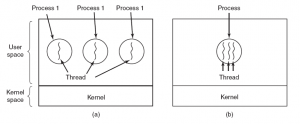
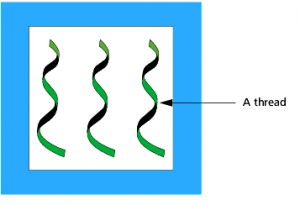
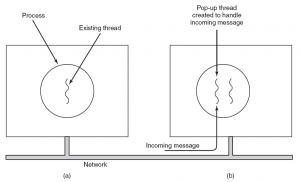
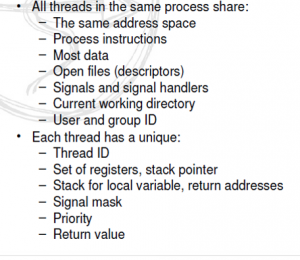
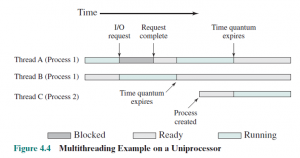
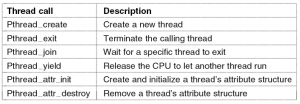





Leave a Comment-